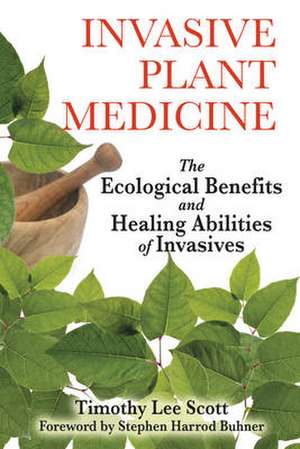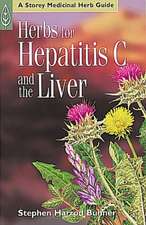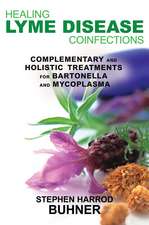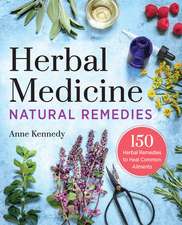Invasive Plant Medicine: The Ecological Benefits and Healing Abilities of Invasives
Autor Timothy Lee Scott Stephen Harrod Buhneren Limba Engleză Paperback – 31 aug 2010
- Explains how invasive plants enhance biodiversity, purify ecosystems, and revitalize the land
- Provides a detailed look at the healing properties of 25 of the most common invasive plants
Most of the invasive plant species under attack for disruption of local ecosystems in the United States are from Asia, where they play an important role in traditional healing. In opposition to the loud chorus of those clamoring for the eradication of all these plants that, to the casual observer, appear to be a threat to native flora, Timothy Scott shows how these opportunistic plants are restoring health to Earth's ecosystems. Far less a threat to the environment than the cocktails of toxic pesticides used to control them, these invasive plants perform an essential ecological function that serves to heal both the land on which they grow and the human beings who live upon it. These plants remove toxic residues in the soil, providing detoxification properties that can help heal individuals.
"Invasive Plant Medicine" demonstrates how these "invasives" restore natural balance and biodiversity to the environment and examines the powerful healing properties offered by 25 of the most common invasive plants growing in North America and Europe. Each plant examined includes a detailed description of its physiological actions and uses in traditional healing practices; tips on harvesting, preparation, and dosage; contraindications; and any possible side effects. This is the first book to explore invasive plants not only for their profound medical benefits but also with a deep ecological perspective that reveals how plant intelligence allows them to flourish wherever they grow.
Preț: 128.46 lei
Nou
Puncte Express: 193
Preț estimativ în valută:
24.58€ • 25.66$ • 20.34£
24.58€ • 25.66$ • 20.34£
Carte disponibilă
Livrare economică 14-28 martie
Preluare comenzi: 021 569.72.76
Specificații
ISBN-13: 9781594773051
ISBN-10: 159477305X
Pagini: 348
Dimensiuni: 155 x 227 x 23 mm
Greutate: 0.43 kg
Editura: Healing Arts Press
ISBN-10: 159477305X
Pagini: 348
Dimensiuni: 155 x 227 x 23 mm
Greutate: 0.43 kg
Editura: Healing Arts Press
Textul de pe ultima copertă
ECOLOGY / ALTERNATIVE HEALTH "I love this book. Brilliant and unique, Tim Scott's new book is about to rock the world of plant enthusiasts. Written for the medical professional, lay person, gardener, botanist, and biologist, it's for everyone who loves and worships at the roots of the green world. Invasive Plant Medicine provides a refreshing new theology of 'invasives, ' or 'messenger' plants as they are so aptly termed by the author. Tim Scott goes deep beneath the surface, where thought, practicality, and poetry combine to create a dynamic new exploration of common plant medicine. Poetic, wise, visionary, and practical, this is my new favorite book about plants." --Rosemary Gladstar, herbalist and founder of United Plant Savers Most of the invasive plant species under attack for disruption of local ecosystems in the United States are from Asia, where they play an important role in traditional healing. In opposition to the loud chorus of those clamoring for the eradication of all these plants that, to the casual observer, appear to be a threat to native flora, Timothy Scott shows how these opportunistic plants are restoring health to Earth's ecosystems. Far less a threat to the environment than the cocktails of toxic pesticides used to control them, these invasive plants perform an essential ecological function that serves to heal both the land on which they grow and the human beings who live upon it. These plants remove toxic residues in the soil, providing detoxification properties that can help heal individuals. Invasive Plant Medicine demonstrates how these "invasives" restore natural balance and biodiversity to the environment and examines the powerful healing properties offered by 24 of the most common invasive plants growing in North America and Europe. Each plant examined includes a detailed description of its physiological actions and uses in traditional healing practices; tips on harvesting, preparation, and dosage; contraindications; and possible side effects. This is the first book to explore invasive plants not only for their profound medical benefits but also with a deep ecological perspective that reveals how plant intelligence allows them to flourish wherever they grow. TIMOTHY LEE SCOTT is an acupuncturist and herbalist with a master's degree in traditional Chinese medicine. He runs a private practice in Vermont and gives workshops on Chinese herbalism, native medicinal plant cultivation, and the benefits of invasive plants.
Notă biografică
Timothy Lee Scott is an acupuncturist and herbalist with a master's degree in traditional Chinese medicine. He runs a private practice in Vermont and gives workshops on Chinese herbalism, native medicinal plant cultivation, and the benefits of invasive plants.
Descriere
The first book to demonstrate how plants originally considered harmful to the environment actually restore Earth's ecosystems and possess powerful healing properties - Explains how invasive plants enhance biodiversity, purify ecosystems, and revitalize the land
- Provides a detailed look at the healing properties of 25 of the most common invasive plants
Most of the invasive plant species under attack for disruption of local ecosystems in the United States are from Asia, where they play an important role in traditional healing. In opposition to the loud chorus of those clamoring for the eradication of all these plants that, to the casual observer, appear to be a threat to native flora, Timothy Scott shows how these opportunistic plants are restoring health to Earth's ecosystems. Far less a threat to the environment than the cocktails of toxic pesticides used to control them, these invasive plants perform an essential ecological function that serves to heal both the land on which they grow and the human beings who live upon it. These plants remove toxic residues in the soil, providing detoxification properties that can help heal individuals.
"Invasive Plant Medicine" demonstrates how these "invasives" restore natural balance and biodiversity to the environment and examines the powerful healing properties offered by 25 of the most common invasive plants growing in North America and Europe. Each plant examined includes a detailed description of its physiological actions and uses in traditional healing practices; tips on harvesting, preparation, and dosage; contraindications; and any possible side effects. This is the first book to explore invasive plants not only for their profound medical benefits but also with a deep ecological perspective that reveals how plant intelligence allows them to flourish wherever they grow.
- Provides a detailed look at the healing properties of 25 of the most common invasive plants
Most of the invasive plant species under attack for disruption of local ecosystems in the United States are from Asia, where they play an important role in traditional healing. In opposition to the loud chorus of those clamoring for the eradication of all these plants that, to the casual observer, appear to be a threat to native flora, Timothy Scott shows how these opportunistic plants are restoring health to Earth's ecosystems. Far less a threat to the environment than the cocktails of toxic pesticides used to control them, these invasive plants perform an essential ecological function that serves to heal both the land on which they grow and the human beings who live upon it. These plants remove toxic residues in the soil, providing detoxification properties that can help heal individuals.
"Invasive Plant Medicine" demonstrates how these "invasives" restore natural balance and biodiversity to the environment and examines the powerful healing properties offered by 25 of the most common invasive plants growing in North America and Europe. Each plant examined includes a detailed description of its physiological actions and uses in traditional healing practices; tips on harvesting, preparation, and dosage; contraindications; and any possible side effects. This is the first book to explore invasive plants not only for their profound medical benefits but also with a deep ecological perspective that reveals how plant intelligence allows them to flourish wherever they grow.
Recenzii
"I love this book. Brilliant and unique, Tim Scott's new book is about to rock the world of plant enthusiasts. Written for the medical professional, lay person, gardener, botanist, and biologist, it's for everyone who loves and worships at the roots of the green world. "Invasive Plant Medicine" provides a refreshing new theology of 'invasives, ' or 'messenger' plants as they are so aptly termed by the author. Tim Scott goes deep beneath the surface, where thought, practicality, and poetry combine to create a dynamic new exploration of common plant medicine. Poetic, wise, visionary, and practical, this is my new favorite book about plants."
"Timothy Lee Scott shows how wrongheaded it is to single out other species as harmful. In nearly every case, the blame for damage done by so-called invasive species lies with us, when we have created an imbalance that opens opportunities for new species to move in. Tim goes beyond simply removing blame from our fellow species. He shows how erstwhile invaders can teach us how to heal damaged ecosystems and ourselves."
"This is an important, insightful book that should be read by all involved in herbal medicine or plant conservation, and more importantly, for all of us who should be questioning authority. In these times of rapid change it is refreshing to find such competent questioning of 'established truths.' Thanks, Tim!"
"So, be warned, this is a dangerous book. Tim Scott will change how you see 'invasives, ' will make you question what you have been taught about them, force you to reexamine what you have read in newspapers, and demand you look more closely at what 'experts' have said."
""Invasive Plant Medicine" is not only a keeper, but a healer."
""Invasive Plant Medicine" is not only a keeper, but a healer." --Irene Watson, Reader Views, September 2010
"Timothy Lee Scott shows how wrongheaded it is to single out other species as harmful. In nearly every case, the blame for damage done by so-called invasive species lies with us, when we have created an imbalance that opens opportunities for new species to move in. Tim goes beyond simply removing blame from our fellow species. He shows how erstwhile invaders can teach us how to heal damaged ecosystems and ourselves."
"This is an important, insightful book that should be read by all involved in herbal medicine or plant conservation, and more importantly, for all of us who should be questioning authority. In these times of rapid change it is refreshing to find such competent questioning of 'established truths.' Thanks, Tim!"
"So, be warned, this is a dangerous book. Tim Scott will change how you see 'invasives, ' will make you question what you have been taught about them, force you to reexamine what you have read in newspapers, and demand you look more closely at what 'experts' have said."
""Invasive Plant Medicine" is not only a keeper, but a healer."
""Invasive Plant Medicine" is not only a keeper, but a healer." --Irene Watson, Reader Views, September 2010
Cuprins
Foreword by Stephen Harrod Buhner
Acknowledgments
Introducing the Weed
PART 1
Waging War on Plants
1 The Politics of Prolific Plants
2 The Science of Invasions
3 Naturally Native: Plants on the Move
4 The Nature of Harm, the Harm to Nature
5 Invasive Herbicidal Impacts
6 The Economics of Weeds
PART 2
The Intelligence of Plants
7 The Deep Ecology of Invasives
8 The Chemistry of Plant Medicine
9 Using Invasive Plants to Treat Invasive Diseases
PART 3
Guide to Invasive Plants: Medicine and Ecological Roles
Artemisia (Artemisia absinthium var. annua)
Barberry (Berberis vulgaris var. thunbergii)
Bindweed (Convolvulus arvensis)
Blackberry (Rubus spp.)
Dandelion (Taraxacum officinale)
English Ivy (Hedera helix)
Garlic Mustard (Alliaria petiolata)
Japanese Honeysuckle (Lonicera japonica)
Japanese Knotweed (Polygonum cuspidatum)
Knapweed or Star Thistle (Centaurea spp.)
Kudzu (Pueraria montana var. lobata)
Oriental Bittersweet (Celastrus orbiculatus)
Plantain (Plantago spp.)
Purple Loosestrife (Lythrum salicaria)
Reed (Phragmites australis)
Russian/Autumn Olive (Elaeagnus spp.)
Scotch Broom (Cytisus scoparius)
Siberian Elm (Ulmus pumila)
Tamarisk (Tamarix spp.)
Thistle (Cirsium spp.)
Tree-of-Heaven (Ailanthus altissima)
White Mulberry (Morus alba)
Wild Mustard (Brassica rapa var. nigra)
Wild Rose (Rosa spp.)
Epilogue
Notes
Bibliography
Index













